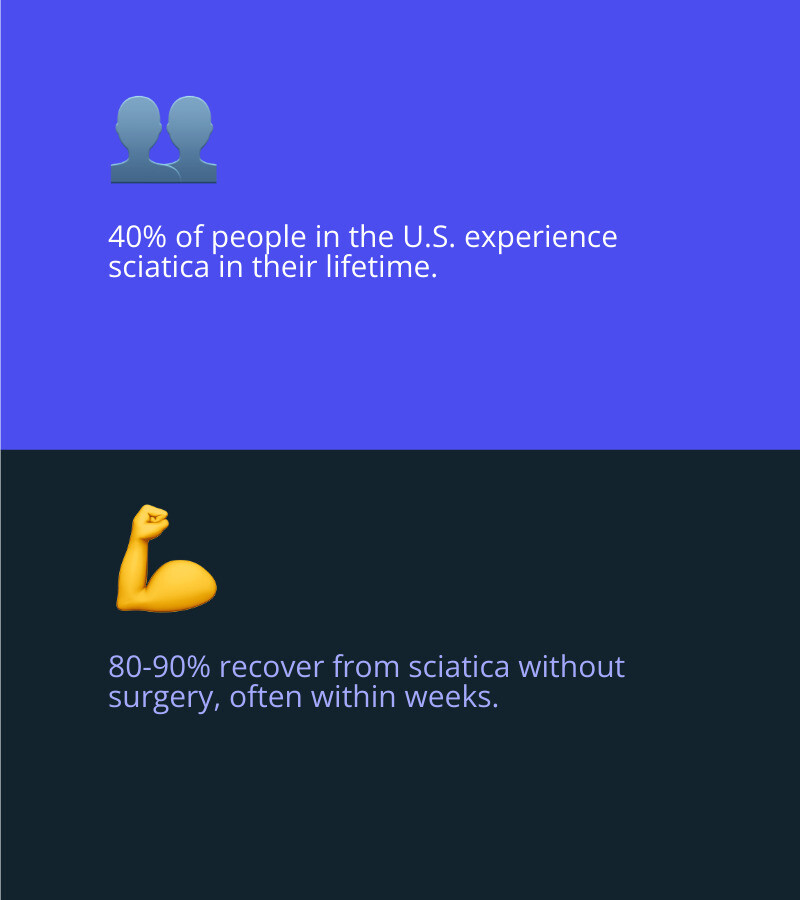Understanding Sciatica and Your Path to Relief
Millions experience the sharp, radiating pain of sciatica, but sciatica relief is possible. Here are the most effective options:
Immediate Relief Methods:
- Cold therapy - Apply ice packs for 15-20 minutes to reduce inflammation.
- Heat therapy - Use heating pads after initial inflammation subsides.
- Topical pain relief creams - Target nerve pain directly at the source.
- Gentle movement - Avoid bed rest beyond 1-2 days.
- Over-the-counter NSAIDs - Reduce pain and inflammation.
When to Seek Medical Care:
- Pain persists beyond 6 weeks.
- Severe weakness or numbness in legs.
- Loss of bladder or bowel control.
- Pain worsens despite home treatment.
Sciatica occurs when the sciatic nerve—the body's longest—is compressed or irritated. It runs from your lower back down each leg, causing a burning sensation, electric shock, or sharp shooting pain.
About 40% of people in the U.S. experience sciatica during their lifetime, but the good news is that most people (80-90%) recover without surgery, often within weeks with proper care. Common causes include herniated discs, spinal stenosis, and muscle inflammation. Understanding your relief options puts you back in control.
I'm Tony Enrico. Through my work with Neuropasil, I've helped thousands find effective sciatica relief with natural, fast-acting topical treatments. My experience shows that combining immediate pain management with proper movement is the fastest path to recovery.

Immediate & Home-Based Sciatica Relief
When sharp, burning sciatica pain strikes, you want relief right now. The good news is that powerful tools are available to use right at home. Sciatica relief often doesn't require a doctor, as 90% of people recover without surgery, usually within weeks, using simple self-care strategies.
At-Home Pain Management Techniques
Cold therapy is your best first move for a flare-up, especially in the first 48-72 hours when inflammation peaks. Apply an ice pack (wrapped in a towel) to your lower back for 15-20 minutes at a time, several times a day. For ice massage, freeze water in a paper cup and massage the painful area for 5-10 minutes.
After the first few days, switch to heat therapy. Heat increases blood flow, relaxes muscles, and promotes healing. Use a heating pad or warm bath for 15-20 minutes. For an effective contrast, try alternating hot and cold therapy (15 minutes of heat followed by 15 minutes of cold) to reduce inflammation while boosting blood flow.
Over-the-counter NSAIDs (non-steroidal anti-inflammatory drugs) like ibuprofen can also reduce pain and inflammation. Always follow package directions and use them for the shortest time necessary. For more guidance, Harvard Health offers excellent insights on Sciatica home remedies and self-care.
The Power of Topical Sciatica Relief
Topical analgesics and specialized nerve pain relief creams offer targeted comfort. Unlike pills, they work directly on the painful area. Look for ingredients like menthol for its cooling sensation that interrupts pain signals and aloe vera to soothe skin and aid absorption. A quality muscle pain relief cream lets you control exactly where the relief goes.
At Neuropasil, our natural formula with aloe, urea, and menthol provides fast-acting relief. The targeted application delivers soothing ingredients directly to the source of discomfort. Our customers use it for various nerve pain conditions, and athletes rely on it for muscle recovery. Topical treatments are convenient and safe, allowing application as needed without the stomach irritation common with oral medications. For more information, visit our guide: More info about Sciatica Pain.
Lifestyle Adjustments for Quick Comfort
It may seem counterintuitive, but avoid prolonged bed rest. Limiting bed rest to a day or two is crucial, as gentle movement keeps muscles strong and reduces pain over time. The importance of movement cannot be overstated.
Proper posture is key. Poor posture adds pressure to your spine. Use an ergonomic chair with lumbar support, keep your feet flat on the floor, and avoid crossing your legs. Position your computer screen at eye level.
Supportive sleeping positions also make a huge difference. Side sleepers should place a pillow between their knees; back sleepers, under their knees. Proper pillow placement helps maintain spinal alignment for a more restful night.
Finally, avoiding prolonged sitting is essential. If you have a desk job, stand and walk for a few minutes every 30 minutes. The Cleveland Clinic offers excellent advice on how Maintaining good posture affects your health.
The Role of Exercise and Physical Therapy
Once the sharp pain subsides, gentle movement is key for long-term sciatica relief. Exercise and physical therapy strengthen supporting muscles, improve flexibility, and boost healing blood flow. We're talking about smart, purposeful exercises that aid recovery, not hinder it.

Gentle Stretches to Ease Nerve Pressure
Stretching gives your sciatic nerve breathing room. Technique is key: no bouncing or forcing through pain. Hold each stretch for at least 30 seconds to allow muscles to relax. Always warm up with a few minutes of gentle walking before stretching.
- The knee-to-chest stretch: Lie on your back with knees bent and gently pull one knee to your chest to release lower back tension. Hold for 30 seconds and repeat 3-5 times per leg.
- The piriformis stretch: A tight piriformis muscle can squeeze the sciatic nerve. To stretch it, sit in a chair, place your ankle on the opposite knee, and lean forward with a straight back until you feel a stretch in your glute.
- The seated hamstring stretch: Sit with one leg straight and lean forward from your hips. Loosening tight hamstrings can provide surprising sciatica relief.
If any movement increases your pain, stop immediately. For additional quick solutions, check out Open up Sciatica Relief: Quick Solutions for Lasting Comfort.
Low-Impact Exercises for Strength and Mobility
Beyond stretching, low-impact exercises build strength for lasting sciatica relief. These activities strengthen your core and improve mobility without jarring the nerve.
- Walking: Start with short, comfortable walks and gradually increase the distance. A gentle walk can ease nerve pain and strengthen spinal support muscles.
- Swimming and aqua-therapy: The water's buoyancy reduces pressure on your spine. Backstroke is especially good for spinal alignment, and even walking in chest-deep water provides gentle resistance.
- Yoga and tai chi: These practices improve flexibility, balance, and core strength. Find an instructor who understands back pain and can offer modifications.
- Core strengthening exercises: Planks, bird-dog poses, and bridges build deep muscles that act as a natural back brace, taking pressure off your spine.
Avoid high-impact activities like running during a flare-up. Research on the effects of self-mobilization techniques for the sciatic nerves shows that active, gentle movement often provides better long-term results than rest. Consistency is more important than intensity.
Medical Treatments and Professional Care
While home care helps many, sometimes professional medical help is necessary for lasting sciatica relief. Knowing when to seek expert guidance is a smart move. A proper diagnosis starts with a review of your medical history and a physical exam to check muscle strength, reflexes, and nerve response.
When to See a Doctor for Sciatica
Don't ignore red flags. See a doctor for moderate to severe pain that doesn't improve after a few weeks of home care, or if symptoms worsen. Worsening leg weakness or numbness is also a serious sign; if you have trouble controlling your leg, standing, or walking, make an appointment.
The most serious warning sign is loss of bowel or bladder control. This indicates a rare condition, cauda equina syndrome, which requires emergency medical care. Similarly, if sciatica symptoms appear after an injury, seek immediate medical evaluation. For a deeper dive, see More info about Sciatica Symptoms.
Professional Medical Interventions
Diagnostic tests help pinpoint the cause. An X-ray can show bone issues, but an MRI is often used to view soft tissues like herniated discs and pinched nerves. A CT scan or an EMG/nerve conduction study may also be used to get more detail on the spinal cord and nerve function.
Doctors have powerful treatment options. Prescription medications like muscle relaxants can ease spasms, and certain antidepressants can interrupt pain signals. Corticosteroid injections deliver potent anti-inflammatory medication directly to the affected nerve root, providing significant relief for many people.
The Mayo Clinic provides excellent comprehensive information about these options: Sciatica - Diagnosis and treatment - Mayo Clinic.
Is Surgery Necessary for Sciatica Relief?
The reassuring news is that 90% of people find sciatica relief without surgery. It's rarely the first option. Surgery is considered after 6 to 8 weeks of failed conservative treatments, or for progressive severe weakness or persistent pain that impacts quality of life.
Common procedures include a diskectomy (or microdiscectomy) to remove the part of a herniated disc pressing on the nerve, and a laminectomy to create more space for the nerve. Even with surgery, recovery involves rehabilitation. Consulting with specialists helps ensure you make the best decision for your situation: Spinal Disorders.
Prevention and Long-Term Outlook
Once you find sciatica relief, you can take meaningful steps to prevent future episodes. This involves building a protective shield for your spine through good habits and daily attention to your body's needs.

Preventing Future Sciatica Flare-Ups
Prevention focuses on reducing strain on your spine. Maintaining a healthy weight is crucial, as extra pounds add pressure to your lower back. Regular exercise, especially for core strength, provides stability. Consistent, gentle activities like walking or swimming are more beneficial than intense, sporadic workouts.
Good posture is also vital. Slouching strains your spine, so use ergonomic furniture and take frequent breaks from sitting. When lifting, always use proper lifting techniques: lift with your legs, not your back. Squat, keep the object close, and engage your core. Finally, quitting smoking can significantly benefit spine health, as nicotine restricts blood flow to your spinal discs.
Understanding the Prognosis and Recovery
The prognosis for sciatica relief is very encouraging. Most people experience significant improvement within 4-6 weeks with proper care. This is supported by research; a combination of natural healing, movement, and targeted treatments creates an environment for recovery.
The high recovery rate is remarkable: 80-90% of people get better without surgery. For chronic sciatica (pain lasting longer than 12 weeks), long-term management strategies like physical therapy, topical pain relief creams, and lifestyle changes can help maintain quality of life. The outlook for recovery remains positive for most people, as our bodies are incredibly resilient. Healing isn't always linear, but the overall trajectory tends toward improvement.
Frequently Asked Questions about Sciatica
It's natural to have questions about nerve pain. Here are answers to the most common questions we get about sciatica relief.
How does sciatica differ from general back pain?
Sciatica isn't just back pain; it's nerve pain that starts in your back. The key difference is the pain's path. Sciatica pain has a specific signature: it radiates from the lower back, through the buttock, and down one leg. It's often described as sharp, shooting, or burning and may include numbness, tingling, or weakness.
General back pain is localized. It feels like a dull ache or soreness in the back and doesn't travel down the leg or cause neurological symptoms like numbness.
Can sciatica go away on its own?
Yes, sciatica often resolves on its own. In fact, 80-90% of people get better without surgery, often seeing significant improvement within a few weeks. Your body has a remarkable ability to heal itself. Most cases resolve with proper self-care, such as using ice and heat, gentle movement, and maintaining good posture.
However, always be alert to warning signs. If pain is severe, getting worse, or you experience significant leg weakness or loss of bladder/bowel control, seek medical attention immediately.
What is the fastest way to find relief from sciatica?
The fastest way to get sciatica relief is a combination approach. There is no single magic button.
For immediate comfort, use ice packs for the first few days to reduce inflammation, then switch to heat to relax muscles. A nerve pain relief cream like Neuropasil provides targeted comfort with its fast-acting formula of menthol, aloe vera, and urea.
Move gently. Avoid prolonged bed rest. Light activities like walking and gentle stretches promote healing. Over-the-counter NSAIDs can also help reduce both pain and inflammation.
For lasting results, it's important to address the root cause. If pain persists, consulting a healthcare professional for a personalized treatment plan is the fastest route to complete recovery. Most people see significant improvement within 4-6 weeks with this combined approach.
Conclusion
Sciatica pain can feel overwhelming, but sciatica relief is absolutely achievable. You have more power over your recovery than you may think. We've seen that this common condition, affecting about 40% of people, responds well to the right combination of care.
Sciatica treatment offers many options. From home remedies like ice packs and gentle stretches to a targeted nerve pain relief cream like Neuropasil or professional medical care, there are multiple paths to relief.
A remarkable statistic offers hope: 80-90% of people with sciatica recover without surgery. Your body can heal with the right support, including consistent gentle movement, proper posture, and effective pain management.
Many customers find Neuropasil's fast-acting formula a game-changer for their sciatica relief journey. Its blend of soothing aloe, penetrating urea, and cooling menthol provides targeted relief directly at the source of discomfort, which is especially helpful when combined with other healing strategies.
You don't have to suffer in silence. While most cases resolve with self-care, don't hesitate to seek professional help if your symptoms worsen or don't improve. Combining home care, professional guidance, and effective topical support is your best strategy for recovery.
If you're ready to experience targeted, natural sciatica relief, I invite you to try Neuropasil. You can Find fast-acting relief for your nerve pain and join thousands who have found their path back to comfortable, active living. Your journey to feeling better starts now.















